THE EDIBLE OUTDOORS #21 - THE AMERICAN PERSIMMON
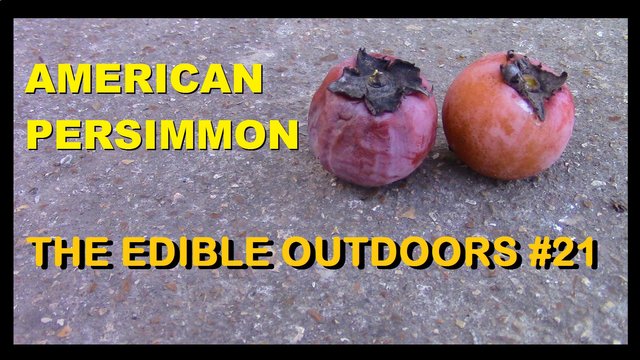
One of the fantastic new edible wild foods that I encountered in the recent years is the American Persimmon (Diospyros virginiana). It is a wonderful tree that can be found across much of South-East, as far west as Texas, Oklahoma, and Kansas and as far up the East coast as Long Island the bottom of Connecticut. I first “met” this tree last fall in Arkansas, and thankfully there are many of them around.

ABOUT THE TREE
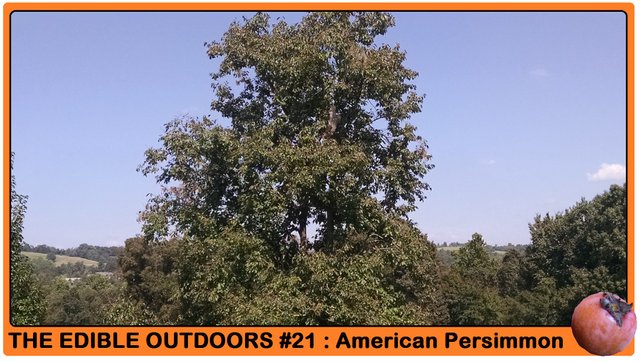
The tree of the American Persimmon can grow over 50 feet tall. Many cultivars can produce seedless fruit without pollination, but this species has dioecious flowers, which means that both a male and a female tree are needed for successful pollination, which leads to fruit. The fruit varies in shades of orange, and most that I have seen are round, and about 1” in diameter or just slightly larger. Trees usually must be more than 5 years old to start fruiting.

VARIETIES AROUND THE WORLD
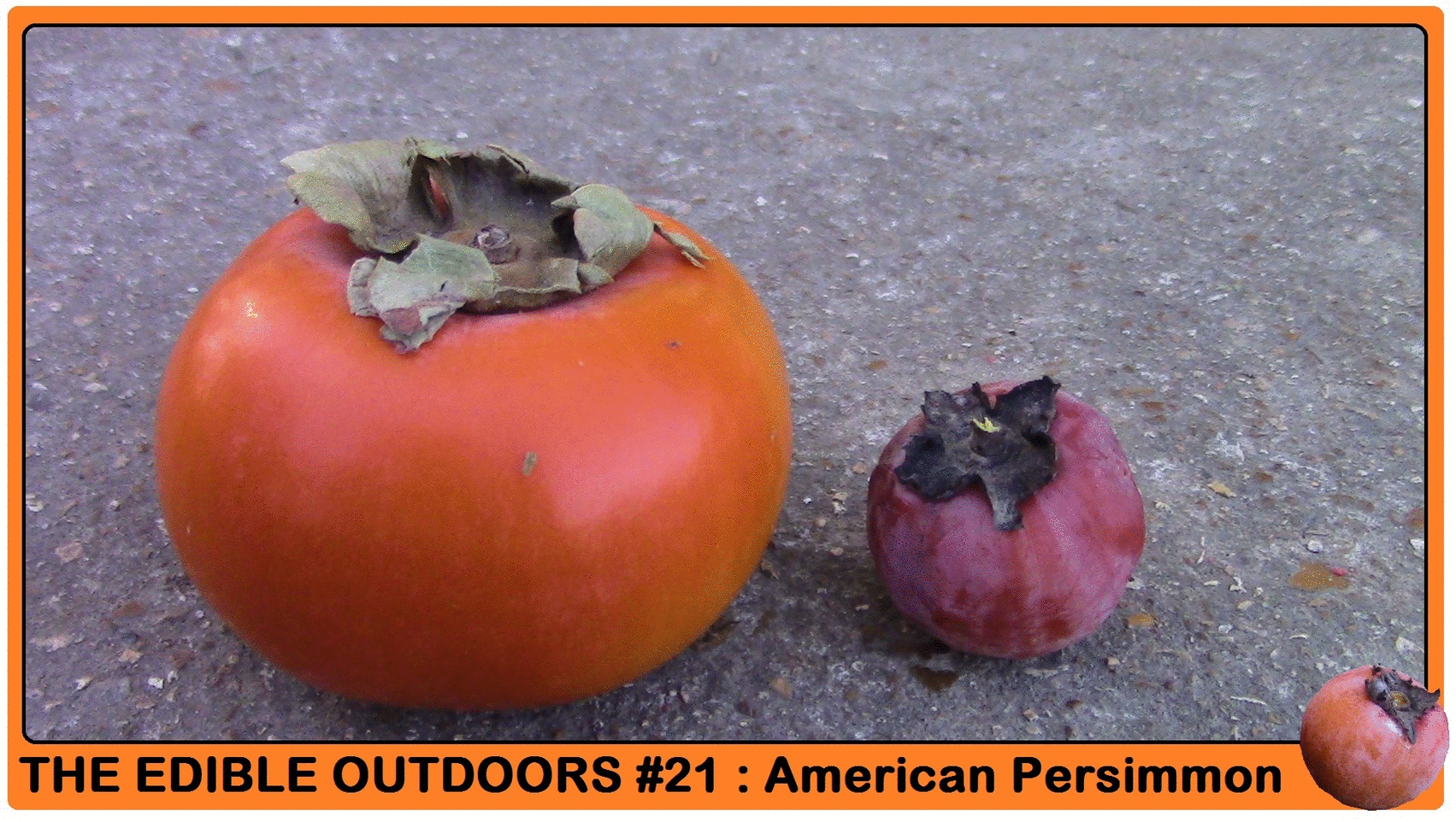
The fruit itself a variation of a kind that can be found around the world. Here, you can see the difference between an Asian variety “Fuyu” and the wild American Persimmon. The two main types of Persimmons that exist are “astringent” and “non-astringent.” The American Persimmon is an astringent variety, while the Fuyu is non-astringent. There are varieties that are native to both the Asian countries and the USA and Mexico. Over four million tons of Persimmons are produced worldwide each year.

HARVESTING WILD FRUIT
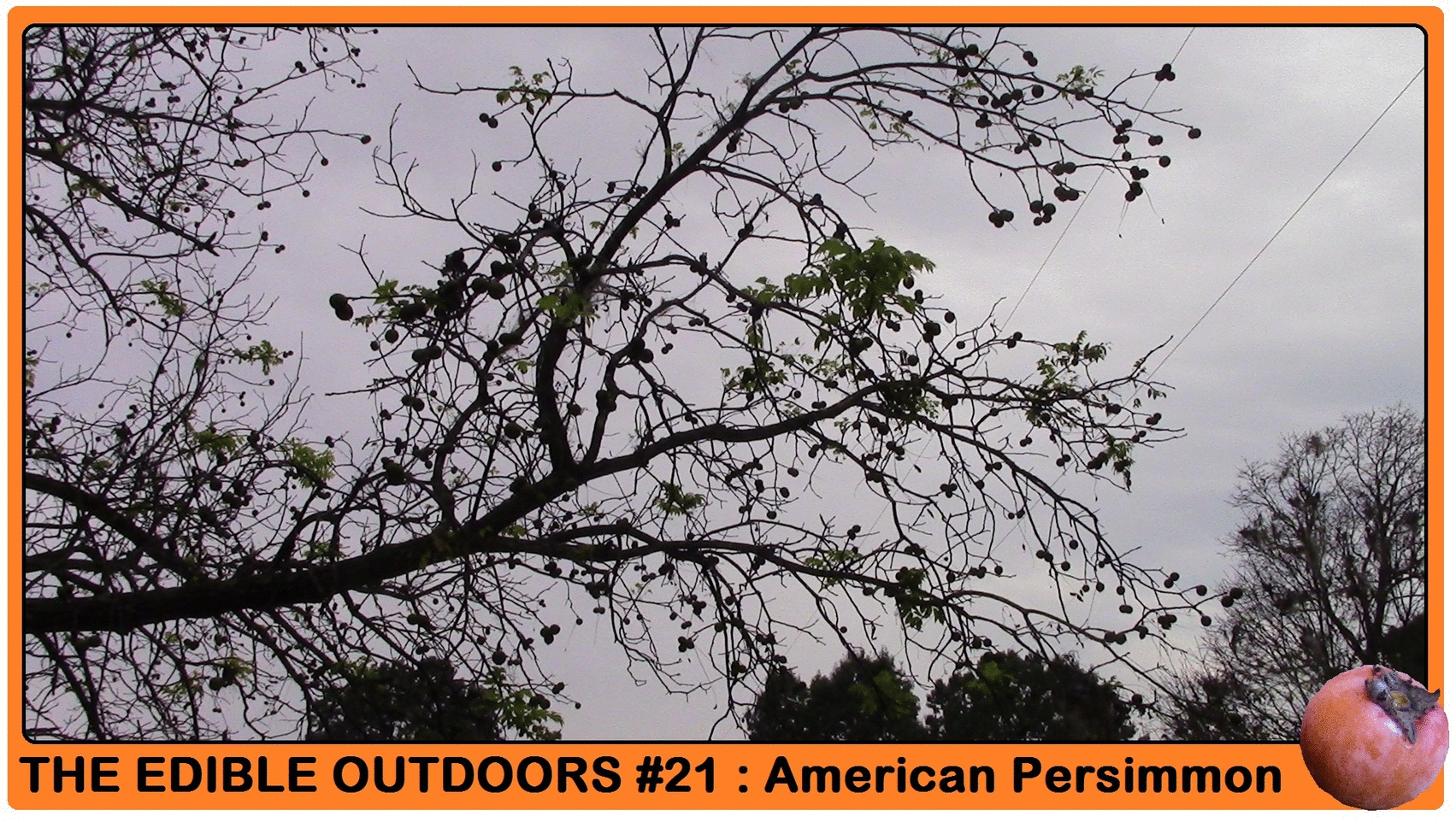
The trees can be very easy to identify once the fruit is ripe. The American Persimmon is the only tree I have seen around here that has small, round, orange fruit on it. One tree can produce a very large quantity of little Persimmons.
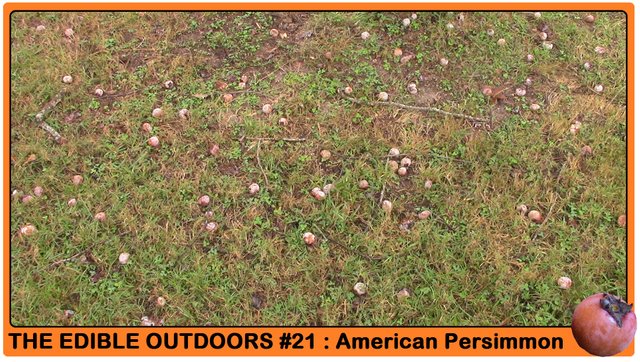
I would liken the flavor to that of an Orange Freezer Pop. However, if you try to eat the American Persimmon before it is fully ripe, you may not want to try it again. As I mentioned above, the American Persimmon is an astringent variety, which means that it can taste very unpleasant and bitter before they are ripe.
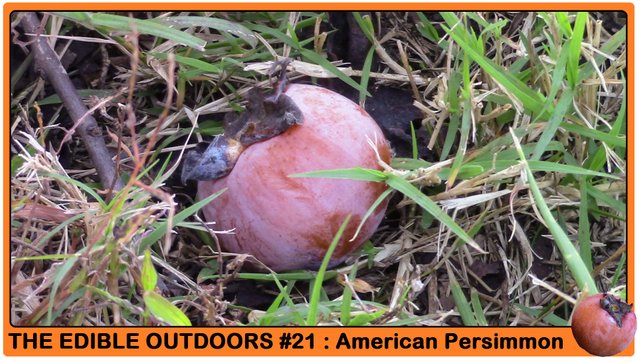
From my experience, two key factors can be used to help make sure that the Persimmons are fully ripe and ready to eat. One was is to wait for a hard frost. After a hard frost, I have noticed that most Persimmons that I pick off of the trees are ready to be eaten. The other method that I use is to wait for the fruit to fall to the ground.
It might seem strange to pick fruit off the ground rather than off the tree, but a lot of kinds of food grow on the ground, and many even grow underground. It seems that a lot of wildlife also waits for these fruits to fall, the most common being deer. Once the fruit start falling, deer can often be seen under Persimmon trees in the early morning or late evening.
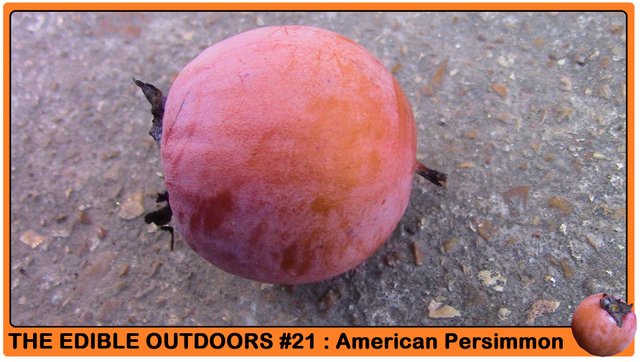
As far as wild food goes, this incredible fruit is one of the best that I can find. They are best to snack on in the woods or on a walk, because the flesh of the ripe Persimmons is very soft. This means that they squish very easily when they are ready to eat. I like to remove the top of the ripe Persimmon and then suck out the contents, discarding the skin.

PROPAGATION
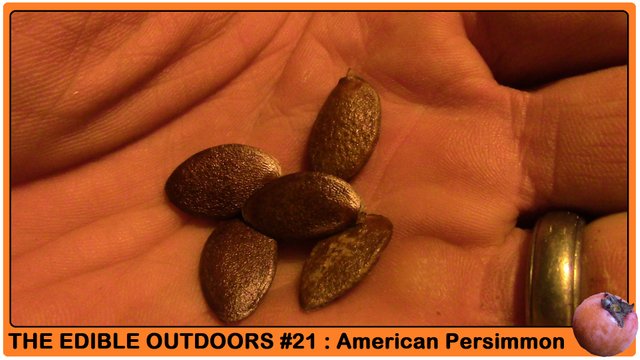
Inside the fruit of the American Persimmons are little oval seeds. It seem that most have about 4 – 6 seeds in them. Though I already mentioned that it take more than five years for a little Persimmon tree to bear fruit, seeds are still one of the best methods to get more Persimmon trees. Propagation techniques like layering do not work, and you can’t get branches or twigs to root either. I’ll be growing some other varieties of Persimmons to attempt grafting them onto some American Persimmon root-stock. The seeds I’ll be growing will be following the natural method, of planting them in the fall for growth in the spring, just like they would normally do in the wild.

CONCERNS
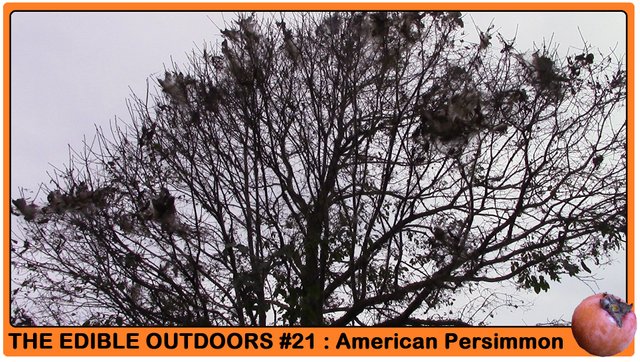
This fall, I noticed an issue that concerned me. A variety of tent caterpillars down here in Arkansas apparently really likes the Black Walnut and American Persimmon trees. This became one of the easiest ways to locate them in the fall. The trees basically looked like they were all covered in cob-webs!
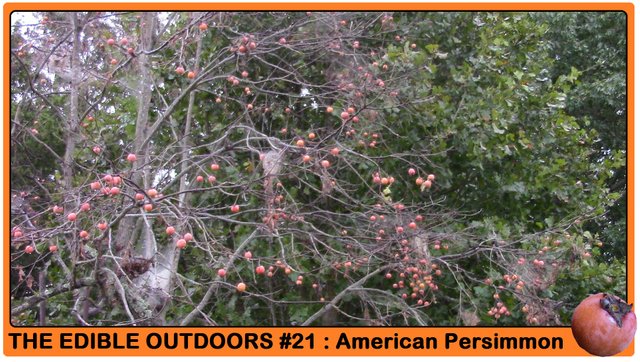
These caterpillars would eat every leaf on the tree, until only branches and fruit remained. When I saw this happening, I became concerned. However, after talking to the locals, it seems this shouldn’t affect the trees, or so they say. I’ll keep an eye on them in the future, but I’m hoping that the locals are right.

VIDEO
Here is my short video on the Persimmon. If you saw THIS POST from @anotherjoe three months ago, you may recognize the video.

As always, be very careful when attempting to enjoy edible wild plants. The best idea is to locate an experienced local who is familiar with the wild edibles in your area. Like many things, attempting to enjoy wild edibles on your own can be dangerous, and perhaps even deadly, so please be careful out there!
Here's previous THE EDIBLE OUTDOORS posts:
- 1-Common Yellow Wood Sorrel
- 2-Lamb’s Quarters
- 3-American Gooseberry
- 4-Stinging Nettle
- 5-Sassafras
- 6-Creeping Charlie
- 7-Dandelion
- 8-Plantain
- 9-Mint
- 10-Garlic
- 11-Purslane
- 12-Elderberry
- 13-Prickly Pear Cacti
- 14-Wild Lettuce
- 15-Passionfruit
- 16-Alfalfa
- 17-Chicory
- 18-American Beautyberry
- 19-Wintergreen plus a bonus, the Partridgeberry
- 20-Wild Chives
- BONUS-Getting Information Into Your Head Before You Need it

Except for the info from this source & this one,


FOLLOW


Hello @papa-pepper,
Congratulations! Your post has been chosen by the communities of SteemTrail as one of our top picks today.
Also, as a selection for being a top pick today, you have been awarded a TRAIL token for your participation on our innovative platform...STEEM.
Please visit SteemTrail to get instructions on how to claim your TRAIL token today.
If you wish to learn more about receiving additional TRAIL tokens and SteemTrail, stop by and chat with us.
Happy TRAIL!
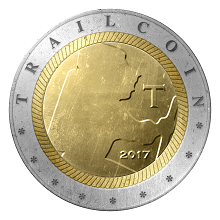
Upvoted by @foraging-trail
Thank you for following and upvoting @foraging-trail
You can find out more about the Steemit Foraging community and guidelines for being upvoted by the @foraging-trail here and here. Join us In the Foraging-Trail and let's discuss Foraging Related Topics
I saw "Edible" so I upvoted
Good Idea!
Here is another thing you can do with the persimmon..
Have you checked them this year to see what kind of winter your going to have??
Might be fun for the family. It was for ours.
We met at americanhomestead a couple weeks ago around the fire pit btw haha.
https://steemit.com/life/@beatitudes8/going-to-be-a-snowy-winter
American persimmons are my #1 favorite native wild fruit, hands down! I eat the whole thing, except the little woody cap, then spit out the seeds - there's nothing wrong with the skin, I don't think. My parents in Arkansas freeze a lot of them every year, so when I visit, I enjoy them! It would be hard to mistake those trees and fruit for anything else, I think. And if you have a game camera, focusing the camera to capture activity under a tree will reveal a lot -- opossums, fox, deer, turkey, bear, coyotes, dogs, raccoons. Everybody loves persimmons! :D And your caterpillar-infested trees should be fine. Happy persimmon eating - lucky you!
@haphazard-hstead, Funny you mention game camera...There is a small-ish fruit tree to which our camera is attached. It does bear fruit with a striking resemblance to the persimmon, although that's the opinion from my untrained eye ;) Whatever the variety, the deer and critters love it to be sure.
In my personal experience, the under-ripe persimmon tastes like biting into a stick of deodorant, quite unpleasant! That was my first time trying, the second was ripe and delicious. There are so many more fruits to explore than the apples and bananas on everyone's counter!
@papa-pepper, you are great - thank you!
haha -- that's a good way to describe an under-ripe persimmon. Nobody wants to try that stick of deodorant, lol! Maybe you will post about your game camera - and show us a fruit or two, too! : )
Persimmons are great! The most popular "sweet" variety available here in Japan has been cultivated enough that they are nearly square, they look like rounded half cubes, there are also astringent varieties though those are most often dried outdoors in the fall and attain an almost taffy-like texture, very soft, gooey and extremely sweet as the astringent compounds have transformed into sugars.
Have you tried drying some of the fruit?
I love persimmons but have never heard or seen American persimmons before. Truthfully, I've been looking for ANY persimmons this year. None of the local grocery stores had them in stock! Sadness for me...
I got persimmons in a food swap 6 years ago. I had no idea what they were. I thought a fancy heirloom tomato. I had been putting in salads. Then I took a picture and posted on FB and found out it was a fruit.
I have a son with nut allergies so I am always looking for interesting desserts for him. I made a persimmons spice cake and it wasn't too bad. It isn't particularly sweet so I had to use maple syrup (just a bit) but the spice cake was yummy.
I went back to using in salads.
@papa-pepper so this one is like that of what @kus-knee ate before
and @haphazard-hstead pointed out it requires bleting before it can be eaten.
Caterpillars mean butterflies ^ ^